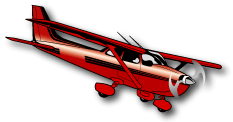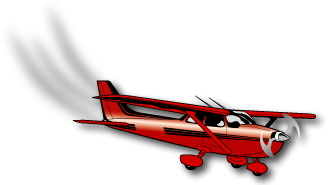 
It’s time for another “interactive” issue of CALLBACK, in which readers can put their hangar flying wisdom to the test. The front page of this issue describes various situations encountered by ASRS reporters. On the back page, you will find the responses actually taken by the reporters of these incidents. Keep in mind that the reported response to the incident may, or may not, represent the optimal solution to the problems described. We hope that these reports will stimulate your thinking and imagination as you “fill in the blanks.”
Situation #1: “We were in a diving right turn…”
While focusing on cockpit communications duties, this flight instructor experienced a disorienting problem:
-
We departed on a dual instructional flight on a Tower Enroute Control IFR flight plan. The IFR student was flying the aircraft. I was working the navigation and communication radios. We were level at 4,000 feet MSL and my high-time student looked comfortable and in control of the aircraft. While being vectored into a 180-degree turn to intercept the final approach course for our destination…we encountered a small amount of turbulence and my student over-controlled the aircraft... During this time I was reading back our new heading and setting the radios for the approach. Several seconds passed. When I looked over, we were in a diving right turn and were well below our assigned altitude.

Situation #2: “No corrective action [was] taken by the Developmental”
How far should an instructor let a training situation go before intervening for safety reasons? Here is how that dilemma developed for an Air Traffic Controller:
-
Aircraft X was southbound via the airway enroute to ZZZ in level flight at FL310. Aircraft Y was northbound direct ZZZ1 at FL320. On the job training was in progress with Developmental Controller working the radar position. I was instructing. Traffic complexity was increasing. As data blocks became cluttered over ZZZ1, the Developmental requested the aid of a Handoff Controller. As the Handoff Controller was joining the sector, the Developmental issued a descent clearance to Aircraft Y to FL300. I advised him to be aware of Aircraft X. Several seconds lapsed with no corrective action taken by the Developmental…

Situation #3: “The fuel quantity indicator failed”
An MD-80 flight crew had to make an on-the-spot decision when the fuel quantity indicator failed shortly after takeoff:
-
Shortly after departing ZZZ and leveling at FL310, the fuel quantity indicator failed. It indicated erratic quantities in all 3 tanks. It seemed to enter a sort of maintenance test mode, at times displaying 3000-3000-3000, and then indicating rapidly changing numbers up and down (several thousand pounds). It displayed a series of dashes in all 3 windows at times and the gross weight window displayed rapidly changing values as well. The indicator would not work on either channel A or B. Consideration was given to returning to ZZZ…

Situation #4: “Iguanas had moved on the runway”

A species of iguana found in the Caribbean, where this incident occurred, are usually between four and six feet in length when fully grown, and can present a reptilian hazard to landing aircraft:
- After going missed for an iguana on the runway, we were revectored for the visual. ATC advised that more iguanas had moved on the runway at taxiway Y. He was unable to issue a landing clearance, and [asked us] to state our intentions…

Situation #5: “I could feel a huge force trying to open the door”
A cabin attendant struggled to prevent a passenger agent from opening the armed door on a B757 and deploying the slide.
- As we were taxiing in, the taxi was very slow, my window at door 1R fogged over and I could not see out clearly. We stopped and I was waiting for the seatbelt sign to go off before disarming [door] 1R. Immediately, at the same time of stopping, I heard and saw the door handle at 1R being opened. I released my seatbelt and grabbed the door handle with both hands, while shouting ‘Stop! Stop! The door is armed!’ I could feel a huge force trying to open the door and could barely hold the handle down…

Situation #1: “We were in a diving right turn…”
-
I immediately took control of the airplane and recovered from the unusual attitude. I found the aircraft out of trim and difficult to control from the right seat. From my preflight weather briefing I knew that we could sort out our problems by climbing to VFR conditions on top of the clouds. I told Approach that we need to climb…We then received clearance [for] a climb to 10,000 feet. We broke out of the clouds at 8,000 feet MSL and were able to verify that all systems were functioning properly and requested an IFR clearance back to our departure airport. After landing, I was asked to call the TRACON, which I did, and explained my unusual attitude and instrument problem.
The lessons I have learned from this are never take your eye off even your most competent student and declare an “Emergency” as soon as you realize you are having a problem complying with the controller’s instructions and your clearance. The controllers did not know what my problems were until I could talk to them from the ground later. Had I declared an emergency, they [ATC] would have understood that I needed time and space to reorganize the cockpit for safe IFR flight.
Situation #2: “No corrective action [was] taken by the Developmental”
-
I took over the frequency to issue separation vectors. Aircraft X advised descending due to TCAS RA and Aircraft Y advised they were climbing. I issued a lower altitude to Aircraft X and sharp turns to both aircraft, but standard separation was not maintained. Contributing factors were rapid and sudden increase in complexity, supervising all controllers at the sector and the supervisor observing us directly, data block clutter at the ZZZ1 VORTAC…and my momentary reluctance to take the sector from a Developmental who I felt was near certification and needed to ‘work through’ the situation…
Situation #3: “The fuel quantity indicator failed”
-
Since fuel flow gauges and associated fuel used indicators were working normally and could be compared with the flight plan, and weather at destination was good, it was decided to continue to ZZZ1. A discussion of this problem with an MD80 instructor pilot was desired to validate our decision to continue, since a second abnormal (i.e., engine failure, fuel leak, abnormal fuel transfer between tanks, weather deterioration at destination, etc.) would make the inoperative fuel quantity indicators critical. We contacted Maintenance Control and advised them of the problem and asked to have Dispatch patch us through to an MD80 Check Captain or at least the Flight Operations Duty Officer. Maintenance Control told us they (Maintenance) were comfortable with us continuing and that the Dispatcher was listening, and he/she was comfortable with it as well…About 15-20 minutes after that, we got an ACARS message that the Flight Operations Duty Officer had been contacted and that he/she agreed we should continue to ZZZ1.
Situation #4: “Iguanas had moved on the runway”
-
…With sufficient useable runway available prior to taxiway Y and our weight checked, I felt that a safe landing could be executed. ATC said to land at [our] own risk due to iguana, and we landed and cleared at taxiway X.
Situation #5: “I could feel a huge force trying to open the door”
- Fortunately, we had a commuting company First Officer (in uniform) sitting in 1A who heard my warning to the Customer Service agent trying to force open the door. He jumped up and grabbed the handle and I shouted through the cockpit door while pounding on the door: ‘Tell them the door is armed!’ I then disarmed the door while the First Officer held the handle so as to not blow the slide… Customer Service did not clear the fogged-over door window which would have given them a visual OK/all clear to open confirmation…along with the requirement that the door be cracked first before attempting to open….Whew, that was a close one!
Meet
the Staff
Harvey “The Hammer” Hartmann

Harvey Hartmann joined the ASRS staff in January 2003 as an Aviation Safety Analyst. As the ASRS Alert Message Coordinator, he is responsible for processing alert messages that are sent to the FAA and other organizations. Harvey also analyzes reports submitted to the program by air traffic controllers, GA pilots, and others.
Harvey brings 36 years of experience as an air traffic controller to his duties at ASRS. He was Staff Officer at the Northern California TRACON (NCT) and San Francisco Bay TRACON; a Supervisor at Bay TRACON, Los Angles Tower, and Brown Tower; and an air traffic controller at several California air traffic control facilities. Prior to his FAA experience, he was in the military for four years.
In addition to all of his contributions to “this old house” at ASRS, Harvey spends his time away from work renovating houses and undertaking remodeling chores.
|


